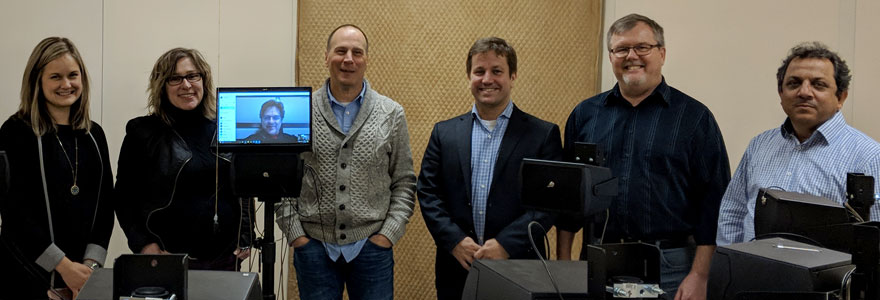News and Updates
Contact
Faculty of Social Science
Social Science Centre
Room 9438
Western University
T. 519-661-2053
F. 519-661-3868
E. social-science@uwo.ca
Research project is a sound collaboration
January 25, 2018
Pictured, from left: Danielle Glista and Susan Scollie (National Centre for Audiology), Leonard Cornelisse (Unitron), Jason Gilliland (HEALab), Don Hayes (Unitron), Tayyab Shah (HEALab)
Story by Rob Rombouts / photo submitted
A new collaboration is bringing together researchers from across Western, with the goal of changing how people hear the world around them.
The Human Environments Analysis Laboratory (HEAL), the National Centre for Audiology, and Unitron, a Kitchener-based hearing aid manufacturer, have come together to research how environmental data can be used to create the next generation of hearing aids.
Susan Scollie is an Associate Professor in Communication Sciences and Disorders, and an investigator at the National Centre for Audiology. Scollie researches hearing aids, and how to improve them.
Hearing aids, Scollie said, are designed to analyse incoming sound and adjust setting based on a variety of listening situations, such as whether the person is listening to music, having a conversation or in a crowd.
The collaborative research will study how hearing aids perform in different environments, and focus on whether adding information about the environment will create more useful information for hearing aids.
To do this, people with hearing aids will be asked to use a smartphone APP to engage in Ecological Momentary Assessment (EMA), or reporting, in real time, about the space they are in. Using the smartphone’s GPS to identify locations, this EMA data will be linked with environmental data in a Geographic Information System (GIS) to create a richer understanding of how elements in the local environment impact hearing.
“This is a very cool use of GIS and GPS,” said Jason Gilliland, HEAL Director, and Professor in the Department of Geography. “Something like this was impossible 10 years ago”.
Scollie became interested in working with HEAL after seeing coverage about a project involving children’s nutrition and their travelling patterns. “I thought, if they can measure information about place,” said Scollie, “we could combine that with sound, and could improve information for hearing aids.”
Gilliland said the research “fits the HEAL’s research mandate, which is to look at the geography and health of vulnerable populations.”
The project is “an example of inter-disciplinary collaboration to solve complex health problems,” said Scollie. “HEAL has the expertise in using information from digital maps to determine what someone’s day looks like, and this fits really well with our work to make hearing aids smarter.”
“We don’t often work with for-profit organizations,” said Gilliland. “But the relationship is great, if you want to have a real-world impact on improving health technologies such as hearing aids, you have to work with a company. It’s a win-win, we get funding for students and postdocs and they get high-end research.”
Other project team members include:
- Andrew Clark, postdoctoral fellow in the HEAL Lab
- Sean Doherty, Professor, Geography & Environmental Studies, Wilfred Laurier
- Danielle Glista, Ph.D., Senior Project Coordinator at the National Centre for Audiology
- Tayyab Shah, Ph.D., postdoctoral scholar in the HEAL lab

